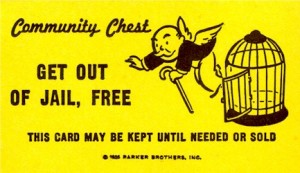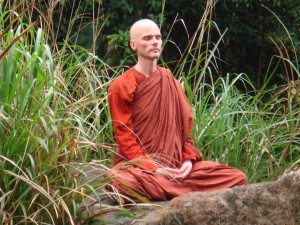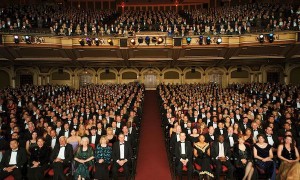What It Feels Like
 In guiding us through the 4th foundation of Mindfulness (often translated — somewhat opaquely — as “investigation of mind objects”) Ven. Analayo quoted a set of similes the Buddha used to illustrate how it feels when each of the classic “hindrances” is not present. These hindrances are: Craving, Anger, Sloth/Torpor (sluggishness), Restlessness/Worry (agitation), and Doubt. What they hinder is: Peace.
In guiding us through the 4th foundation of Mindfulness (often translated — somewhat opaquely — as “investigation of mind objects”) Ven. Analayo quoted a set of similes the Buddha used to illustrate how it feels when each of the classic “hindrances” is not present. These hindrances are: Craving, Anger, Sloth/Torpor (sluggishness), Restlessness/Worry (agitation), and Doubt. What they hinder is: Peace.
Not craving is like getting out of debt.
Not being angry is like recovering from an illness.
Not feeling sluggishness is like getting out of jail.
Not feeling agitated is like being freed from slavery.
Not being in doubt is like arriving safely after a dangerous journey.
I love these similes because instead of suggesting that craving, anger, etc. are somehow failings on my part that need to be eradicated…..they’re just unpleasant, painful, limiting states of mind that it would be a joy to be free of!
The instruction, then, is not to try to force myself not to crave something, or get angry, etc., but just to notice whenever I’m NOT craving or angry or sluggish, etc.….and then to enjoy the feeling of being FREE!!!
How liberating.
Let the Mind Rest on the Body
 I’m back from the deeply transformative 10-day retreat led by Ven. Analayo (shown in photo), followed by the Community Dharma Leader workshop, and I’m feeling a bit overwhelmed with so much to write about.
I’m back from the deeply transformative 10-day retreat led by Ven. Analayo (shown in photo), followed by the Community Dharma Leader workshop, and I’m feeling a bit overwhelmed with so much to write about.
So, for today, I’ll just leave you with the opening phrase, which Ven. Analayo used every morning and every afternoon (always the same, word for word), as he led us on a guided meditation/contemplation through the series of 7 practices outlined in the Satipatthana Sutta that are common to the both Pali and Chinese versions of the text. (The practices are: Anatomical Parts, Elements, Cemetery Contemplation, Feeling Tone, Contemplation of Mind, Hindrances, Enlightenment Factors.)
At every sit, this opening phrase would wash over me like a wave of calm, so now I start every meditation by saying it to myself:
“We are aware of the body in the sitting posture, and we let the mind rest on the body just as the body rests on the cushion.”
Ahhhhh.
***
To listen to a sample of the guided meditation (40 minutes), beginning with this opening phrase, click here.
Check Back on April 27
 I leave tomorrow for two retreats at Spirit Rock: the first will be a silent retreat led by Bhikkhu Analayo, Phillip Moffitt and Shaila Catherine; the second will be more of a workshop retreat (half silent, half not), which begins my 2-year training as a Community Dharma Leader (CDL).
I leave tomorrow for two retreats at Spirit Rock: the first will be a silent retreat led by Bhikkhu Analayo, Phillip Moffitt and Shaila Catherine; the second will be more of a workshop retreat (half silent, half not), which begins my 2-year training as a Community Dharma Leader (CDL).
Ten years ago, Analayo wrote what is now considered the standard text on the satipatthana sutta (Satipatthana: The Direct Path to Realization, available as a FREE download here). More recently, he wrote a companion book, Perspectives on Satipatthana, which compares the Pail and Chinese versions of this sutta, and which is required reading for the upcoming retreat. (Sounds boring, I know, but it’s actually quite fascinating. At least to me.)
After that, I’ll have a day to spend with friends Tony and Maggie, who live in San Francisco, and then back to Spirit Rock for the CDL workshop/retreat led by Eugene Cash, Larry Yang, Gina Sharp, and Pamela Weiss. There are two assigned texts for the CDL retreat: one is Analayo’s first Satipatthana book (which I love) and the other is Joanna Macey’s Coming Back to Life book (which I DON’T….and about which I’ve posted earlier.)
Anyway….I leave on April 4 and won’t get back until April 24. It will take me a while to get back into my “normal” routine, so don’t expect another post until Monday, April 27.
Hope you’ll check in with me then.
Travel & Desire
 I’m getting ready to leave on Saturday for back-to-back retreats at Spirit Rock, which I will post more about tomorrow. In the mean time, I’m doing laundry, making lists and stocking up on raw almonds and Jolly Rancher candies (my emergency rations for airline travel). I’m also reading passages from Invisible Cities, by Italo Calvino, which is one of my favorite pre-trip rituals. Here’s a sample:
I’m getting ready to leave on Saturday for back-to-back retreats at Spirit Rock, which I will post more about tomorrow. In the mean time, I’m doing laundry, making lists and stocking up on raw almonds and Jolly Rancher candies (my emergency rations for airline travel). I’m also reading passages from Invisible Cities, by Italo Calvino, which is one of my favorite pre-trip rituals. Here’s a sample:
Cities & Desire 2
At the end of three days, moving southward, you come upon Anastasia, a city with concentric canals watering it and kites flying over it. I should now list the wares that can profitably be bought here: agate, onyx, chrysoprase, and other varieties of chalcedony; I should praise the flesh of the golden pheasant cooked here over fires of seasoned cherry wood and sprinkled with much sweet marjoram; and tell of the women I have seen bathing in the pool of a garden and who sometimes–it is said–invite the stranger to disrobe with them and chase them in the water.
But with all this, I would not be telling you the city’s true essence; for while the description of Anastasia awakens desires one at a time only to force you to stifle them, when you are in the heart of Anastasia one morning your desires waken all at once and surround you. The city appears to you as a whole where no desire is lost and of which you are a part, and since it enjoys everything you do not enjoy, you can do nothing but inhabit this desire and be content.
Such is the power, sometimes called malignant, sometimes benign, that Anastasia, the treacherous city, possesses; if not for eight hours a day you work as a cutter of agate, onyx, chrysoprase, your labor which gives form to desire takes from desire its form, and you believe you are enjoying Anastasia wholly when you are only its slave.
Sip into Spring
 Last week a mug of Chilly Morning Chai sounded good….but today I’m ready for lemonade. (Sometimes “impermanence” is your friend!)
Last week a mug of Chilly Morning Chai sounded good….but today I’m ready for lemonade. (Sometimes “impermanence” is your friend!)
Rosewater Lemonade
(from RETREAT: The Joy of Conscious Eating)
4 cups water
1/2 cup fresh lemon juice
3 Tbs. honey
1 Tbs. rosewater (to taste)
Combine all ingredients. Stir well until honey is completely dissolved. Adjust sharpness and sweetness to taste.
Chill and serve.
As an Experiment…
 The Dharma Book KM Group I’m a part of is working its way (slowly and mindfully) through Joseph Goldstein’s Mindfulness: A Practical Guide to Awakening. We met last night and got to talking about a practice Joseph suggests in the section on Mindfulness of Mind:
The Dharma Book KM Group I’m a part of is working its way (slowly and mindfully) through Joseph Goldstein’s Mindfulness: A Practical Guide to Awakening. We met last night and got to talking about a practice Joseph suggests in the section on Mindfulness of Mind:
“As an experiment, pay attention to the next time you experience a strong wanting in the mind. Stay as mindful as possible of how it manifests in the mind and body. And then notice as the wanting disappears, either in a moment or gradually over time. Instead of rushing back to the breath or some other object of meditation, pay attention to the mind free of wanting, experiencing the coolness and peace of that state.”
Since we’re more likely to pay attention to the times when our minds are NOT free of wanting, the group decided that we will try Joseph’s suggestion — at least occasionally — over the next couple of weeks. It sure would be nice, we all agreed, to be more aware when we actually ARE experiencing a little coolness and peace.
Try it with us!
Let the Concert Begin
 Today’s post comes from an early book of collected essays (published in 1974) titled: What is Meditation, edited by John White. Of course mediation has been taught for more than 2600 years, so when I say “early,” I mean early for us Westerners.
Today’s post comes from an early book of collected essays (published in 1974) titled: What is Meditation, edited by John White. Of course mediation has been taught for more than 2600 years, so when I say “early,” I mean early for us Westerners.
Here’s a sample from The Art of Meditation, written by one of these “early” practitioners, Alan Watts.
“We are…out of touch with reality. We confuse the world as talked about, described, and measured with the world as it actually is. We are sick with a fascination for the useful tools of names and numbers, of symbols, signs, conceptions, and ideas. Meditation is therefore the art of suspending verbal and symbolic thinking for a time, somewhat as a courteous audience will stop talking when a concert is about to begin.
“Simply sit down, close your eyes, and listen to all sounds that may be going on–without trying to name or identify them. Listen as you would listen to music. If you find that verbal thinking will not drop away, don’t attempt to stop it by force of willpower. Just keep your tongue relaxed, floating easily in the lower jaw, and listen to your thoughts as if they were birds chattering outside–mere noise in the skull–and they will eventually subside of themselves, as a turbulent and muddy pool will become calm and clear if left alone.”
***
(Thanks, Thomas, for sharing that gem.)
What Meditation is Not
 from Mindfulness in Plain English, by Bhante Gunaratana:
from Mindfulness in Plain English, by Bhante Gunaratana:
“Misconception #1: Meditation is Just a Relaxation Technique
“Relaxation is a key component of meditation, but vipassana-style (mindfulness) meditation aims at a much loftier goal…All mediation procedures stress concentration of the mind, bringing the mind to rest on one item or one area of thought. Do it strongly and thoroughly enough, and you achieve a deep and blissful relaxation….
“Vipassana seeks another goal: awareness. Concentration and relaxation are considered necessary concomitants to awareness. They are required precursors, handy tools, and beneficial byproducts. But they are not the goal. The goal is insight. Vipassana mediation is a profound religious practice aimed at nothing less than the purification and transformation of your everyday life.”
***
One can quibble with the use of “religious” in that last sentence (see yesterday’s post), but there’s no disputing the profound nature of this practice.
On Not Believing
 I’ve been going through my library this morning, looking for something to read/discuss at the Sunday Morning Sangha (if called upon) and I came across this oldie-but-goodie by Stephen Batchelor: Buddhism Without Beliefs.
I’ve been going through my library this morning, looking for something to read/discuss at the Sunday Morning Sangha (if called upon) and I came across this oldie-but-goodie by Stephen Batchelor: Buddhism Without Beliefs.
“First and foremost the Buddha taught a method (‘dharma practice‘) rather than another ‘-ism.’ The dharma is not something to believe in but something to do. The Buddha did not reveal an esoteric set of facts about reality, which we can choose to believe in or not. He challenged people to understand the nature of anguish, let go of its origins, realize its cessation, and bring into being a way of life…
“An agnostic Buddhism would not regard the dharma as a source of ‘answers’ to questions of where we came from, where we are going, what happens after death. He would seek such knowledge in the appropriate domains: astrophysics, evolutionary biology, neuroscience, etc. An agnostic Buddhist is not a ‘believer’ with claims to reveal information about supernatural or paranormal phenomena, and in this sense is not ‘religious.’…
“An agnostic Buddhist eschews atheism as much as theism, and is as reluctant to regard the universe as devoid of meaning as endowed with meaning. For to deny either God or meaning is simply the antithesis of affirming them. Yet such an agnostic stance is not based on disinterest. It is founded on a passionate recognition that I do not know. It confronts the enormity of having been born instead of reaching for the consolation of a belief. It strips away, layer by layer, the views that conceal the mystery of being here…
“Such deep agnosticism is an attitude toward life refined thorough ongoing mindful awareness. It may lead to the realization that ultimately there is neither something nor nothing at the core of ourselves that we can put a finger on. Or it may be focused in an intensive perplexity that vibrates through the body and leaves the mind that seeks certainty nowhere to rest.”
***
I don’t think there’s anything here that would be controversial. But I do think it could get a conversation going. Especially since Batchelor went on to write: Confessions of a Buddhist Atheist.
Every Moment
 I just listened to a sweet little 2-minute dharma talk given by Sylvia Boorstein at the month-long retreat going on right now at Spirit Rock. (click here)
I just listened to a sweet little 2-minute dharma talk given by Sylvia Boorstein at the month-long retreat going on right now at Spirit Rock. (click here)
It’s definitely worth taking the time to listen, but if you haven’t got the 2 minutes, here’s the key teaching:
“Every moment of mindfulness erases a moment of conditioning.”
